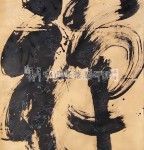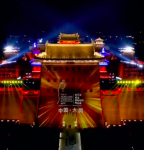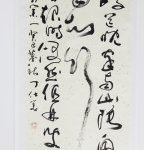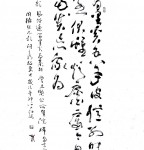In learning Chinese caligraphy it is necessary to copy rubbings from stone tablets. How do we choose these rubbings? As a nation of calligraphers China has thousands of rubbings from stone tablets. Opinions may differ on the same stone tablet-praised by some and scorned by others. They are controversial. My own opinion is that the learner should choose rubbings of the four great schools of calligraphy-Yan, Liu, Ou and Zhao. The four have distinct features. The Ou school is marked by characters of strength. The Yan school produces characters with strong sinews or powerful framework. The_ characters of the Liu school are compared to the bones of the body. Zhao characters are compared to the flesh of the body. A description of each follows.
Yan Style of Calligraphy
Yan Zhenqing (709-785) was also known as Yan Qingchen. His ancestral home was Wannian, Jingzhao (now Xi'an, Shaanxi Province). He himself said that he was a native of Langya (now Linyi, Shan-dong Province). A prominent official in the Tang Dynasty, he was titled Duke of Lu Commandery. People respectfully called him Yan Lu Gong. He was a great-calli-grapher at the height of the Tang Dynasty's power and glory. An early representative work was Duo Bao Ta Bei. A fine work representative of his middle era was Dong Fang Shuo Hua Xiang Zan Bei. Yan Shi Jia Miao Bei was a powerful work representative of his later years. The style of his calligraphy is bold and vigorous, showing spaciousness and breadth.
Before Yan Zhenqing formed his own calligraphic system, most calligraphers had followed or imitated the calligraphy of Wang Xizhi and his son, Wang Xianzhi. The Wang style is for the most part natural and unrestrained, elegant and refined. It can be compared to a romantic Chinese scholar or a classic Chinese beauty. Wang Xizhi's style is truly beautiful. However, it lacks strength and vigor. The atmosphere of Yan Zhenqing's calligraphy may be compared to the imposing appearance of a marshal, or it is as majestic as a sovereign ruler. The style has grandeur and loftiness. Like the poetry of Li Bai and Du Fu, Yan calligraphy embodies the grand spirit of the Tang Dynasty as its height. Yan calligraphy is as robust as the sun. After Wang Xizhi's time (Jin Dynasty) Chinese calligraphic art reached an epoch-making peak with the appearance of Yan Zhenqing's calligraphy. It became the fashion in the Song Dynasty to take Yan's calligraphy as a model for copying. This has persisted to this day, over a thousand years later.
There are many Yan-style rubbings from inscriptions on stone tablets. To copy small characters, get Ma Gu Shan Xian Dan Ji. To copy medium-sized characters, try the rubbing entitled Duo Bao Ta Bei. For big characters, try Yan Shi Jia Miao Bei.
Liu Style of Calligraphy
Liu Gongquan (778-865), alias Liu Chenxian, was a native of Huayuan, Jing-zhao (now Yaoxian County, Shaanxi Province). A leading official of the Tang Dynasty, he was titled Duke of Hedong Commandery and popularly called Liu He Dong. A great calligrapher of his time, he was ranked alongside Yan Zhenqing as one of two great calligraphers. The two were referred to as Yan-Liu. Forthright, Liu had great integrity and was not careless. He was candid in giving his views. When the emperor asked him how one could write upright characters, he replied that it depended on the mind of the writer. When a man set the purpose of his life right, he would be able to write upright characters. On hearing this, the emperor's expression changed, as he thought that Liu was reprimanding him.
This episode was described by later generations as cal-ligraphically reprimanding the emperor. Liu Gongquan was speaking of the relationship between the mind and the brush. Before setting brush on scroll to paint bamboo, the painter must have the shape of the bamboo in his mind. In the same way a calligrapher sets his mind on the shape of characters before he actually writes them. This approach is common to both painting and calligraphy. The style of Liu calligraphy may be compared with the integrity of the calligrapher. The framework is very strictly executed. The style is strict and rigorous. Those wishing to imitate Liu's style in small characters may get copies of rubbings known as the Diamond Sutra and GUI' Lin Shi. For medium-sized characters obtain a copy of the rubbing called Tang Jian Yi Da Fu Bei. For big characters Xuan Mi Ta Bei and Shen Ce Jun Bei are excellent specimens.
Ou Style of Calligraphy
Ouyang Xun (557-641), also known as Xinben, was a native of Linxiang (now Changsha, Hunan Province). He was also a leading official of the early Tang Dynasty, serving the crown prince. The framework of characters in Ou calligraphic style is very rigid. His characters have strength, and his style has solemnity and grace. Recommended rubbings in Ou calligraphic style are: Jiu Chen Gong Li Quan Ming, Hua Du Si Bei, Huang Fu Dan Bei and Yu Gong Gong Wen Yan Po Bei.
Zhao Style of Calligraphy
Zhao Mengfu (1254-1322), alias Zi'ang and Xuesong Daoren, was a native of Huzhou (now Wuxing, Zhejiang Province). His style is mellow and full, handsome and rather refined, not at all vulgar. The structure is compact and well proportioned. We find flexibility that is rather natural. The running script is particularly graceful and elegant.
Sometimes the technique of writing in Zhao style appears to be more dexterous than required, resulting in lack of strength in the brush stroke. The calligraphy of Zhao Mengfu's later years is more mature, with vigorous strokes that display power.
Rubbings of inscriptions from stone tablets in Zhao style are as follows: Dao De Jing (in small characters), Da De Fa Shi Bei (in medium-sized characters), and Dao Jiao Bei andMiao Yan Si Bei (in big characters) of the four schools of calligraphy listed above Zhao style appears the easiest to learn. Beginners, however, with little basic skill, may find that their writing lacks strength if they start with Zhao style. This point should not be overlooked. If they begin their learning process by imitating Yan, Liu or Ou styles instead, they will gain strength in their writing. They may learn Zhao style later. This will enable them to add mellowness and fullness to their calligraphy. Their writing will have strength plus elegance. The bones will take on flesh, as it were. They will improve an already good script.
Apart from the four schools of Chinese calligraphy there are the works of Zhong You and Wang Xizhi, originators of regular script. Their works have won respect and high praise from calligraphers through the ages.
The above is elementary knowledge about rubbings of inscriptions on stone tablets used as writing specimens. Each school is different from the other and cannot be treated in the same way. The choice of rubbings depends on personal preference. No one can make decisions for you, for taste is a personal matter. You have to decide for youself. Choose the one you think you like best and you will achieve good results with half the effort. Otherwise, it will be" half the result with twice the effort, as a Chinese proverb says.
| < Prev |
|---|













